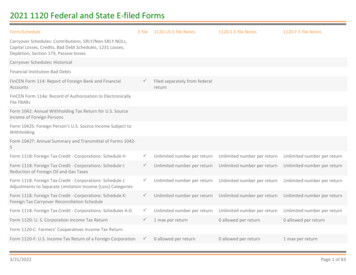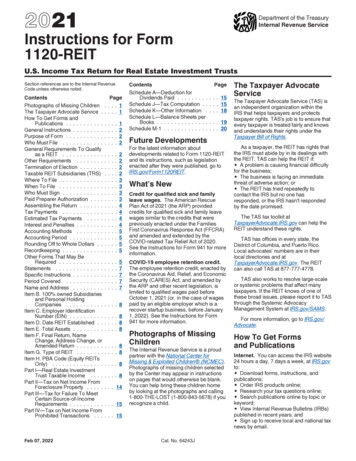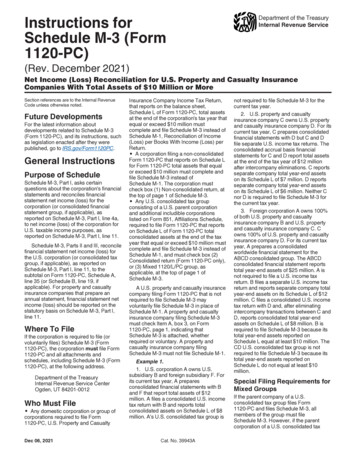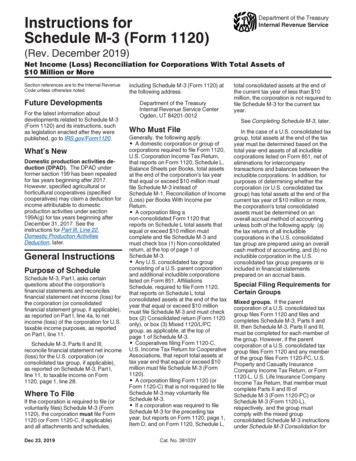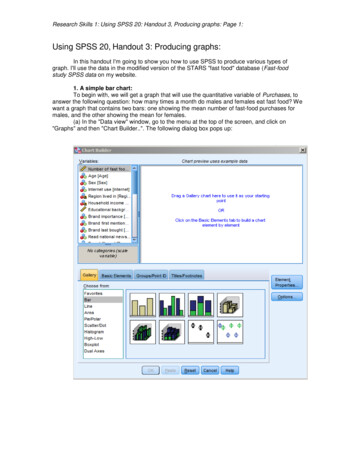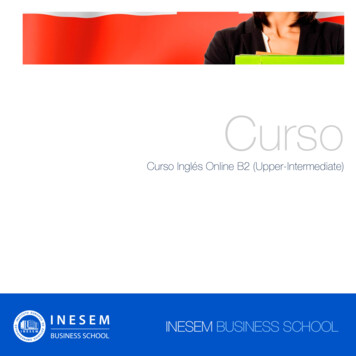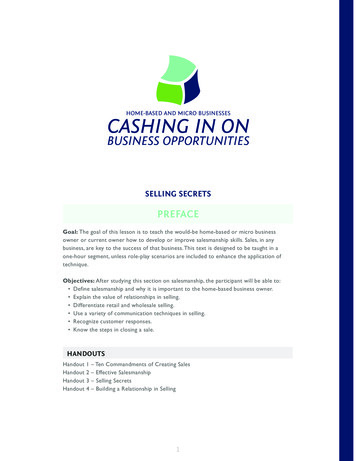
Transcription
Intermediate 1120SSolving S Corp ProblemsHandoutJune 2011
Table of ContentsPART 1 – Wage and Compensation IssuesLoans to ShareholdersReasonable WageAuto Policy and Health InsuranceSample W-2 Reporting Auto/Health CorrectlyRetirement Plan ContributionsCharitable ContributionsHome Office345671011PART 2 – Distribution and Basis IssuesThe Golden RuleSection 351 Tax Free Exchange Sample StatementsCalculating basis for a mid-year exchangeSample Completed 351 StatementsCalculating Beginning Balance SheetEnding Balance SheetSchedule M-1 – tie return to booksSchedule M-2 – Undistributed IncomeBIG TaxExternal BasisExample of Excess Distributions -- Debt ReliefExample of Excess Distributions – Loan to ShareholderTD 9428 Text “Open Account” 2011 TaxBuddha.com212131418192022232426272829
Loans to ShareholdersThe issue is a “loan” may be recharacterized as wages under audit, subject to payroll tax,penalties and interest.Here’s what sorts of bad things can happen under recharacterization:UI & ETT (3.5%)Employer A(Correctly classifiespayment as wages)Employer B(Misclassifies payment as“loan”)* 245 245CA SDI (1.1%)220PIT (6%)1,200FUTA (6.2%)56434FICA (ER 7.65%)1,5301,530FICA (EE 5.65%)1,130FIT (25%)5,000Total due for 1 year 1,831 9,759*This example is for one worker paid 20,000 that is recharacterized as Wages, not including penalty and interest.Elements for a “good” loan:1.) Note2.) Note recorded in corporate minutes3.) Reasonable Interest Rate4.) Payments made on note5.) Cancelled checks to prove payments were made per Note. 2011 TaxBuddha.com3
Officer Compensation“Reasonable Wage”US Department of Labor, Bureau of Labor Statistics.http://www.bls.gov/sae/home.htm541200 is NAICS code for Tax Preparers (I googled this number).Quarterly Census of Employment and WagesSeries Id: ENU06013505541213State:CaliforniaArea:Contra Costa County, CaliforniaIndustry: NAICS 541213 Tax preparation servicesOwner:PrivateSize:All establishment sizesType:Average Annual PayYear Annual 2001 34,959 2002 21,081 2003 21,017 2004 23,901 2005 29,532 2006 28,619 2007 31,258 2008 30,494 : Preliminary.Year AnnualSeries 54121CaliforniaContra Costa County, CaliforniaNAICS 54121 Accounting and bookkeeping servicesPrivateAll establishment sizesAverage Annual PaySo it’s better to be a bookkeeper than a tax preparer.Souce: http://data.bls.gov/PDQ/outside.jsp?survey en 2011 TaxBuddha.com42001 490152002 497952003 471692004 499182005 520782006 548522007 567592008 60233(P)
Automobile PolicySAMPLE CORPORATE POLICY to be adopted at a Board of Director’s Meeting for anAccountable Plan:“The corporation establishes a policy of reimbursing employees for miles driven for thecorporation, in an amount equal to the maximum allowable federal deduction per mile,provided the employee submits an expense report documenting the date, mileage, and thebusiness purpose for the trip.”Health InsuranceThe rules about deducting health insurance were relaxed about 2007-08, now allows aplan in the name of the individual to be paid by the corporation (reimbursed), but greaterthan 2% shareholders’ health benefit is not deductible to the corporation.You’ll want to include health insurance benefits as part of the officer compensationpackage voted on at a Board of Director’s Meeting also. 2011 TaxBuddha.com5
Sample W-2 – The proper way to report Auto/HealthIf you’re reporting personal use of a corporate owned automobile, or company paidhealth insurance for a more than 2% shareholder, you include the value(s) in Box 1 andBox 16, and in Box 14.The taxable benefit is included as wage in Boxes 1 and 16, but not included as wage basefor Social Security nor Medicare in boxes 3 and 5. These benefits are not FICA taxable.Include a note or notes in Box 14 as “Auto” and/or “Health” with the amounts.These are not deductions for the corporation as either Auto or Health, the corporationdeducts these expenses as wage. It becomes income to the employee, and must bereported. The shareholder may be able to deduct the amounts from their personal Form1040. Auto use income is probably just taxable. Health insurance may be deducted asSelf-Employed Health Insurance to the limit of wages. 2011 TaxBuddha.com6
Retirement plan contributionsRetirement plan contributions for sole-owner S Corporations can be somewhat confusing.This article is ONLY about SEP’s and 401(k)s for 100% owners of S Corporations with no otheremployees.I don’t discuss tax returns for retirement plans. I have also not included the “catch up”contribution limits for the 401(k). I’m presuming in my example the shareholder is under 50years old.Employees need to be considered in retirement planning, so if you have other employees orexpect to have employees “someday,” I’d use a professional administrator.There are two different sources of contributions to retirement plans: Employee and Employer.Money withheld from employees through payroll is called an “Elective Deferral.” Theseamounts are excluded from income tax, but are still subject to FICA, FUTA and SDI taxes.Money contributed by an employer is not only excluded from the employee’s income tax, butalso not subject to FICA, FUTA nor SDI tax, because it is not payroll.The limits on contributions from either source are based on W-2 income. The limits do notinclude the pass through amounts from the K-1, as these are not earned income. The amount onthe K-1 is irrelevant for the retirement plan contribution calculation.When the employer, the S Corporation, makes a contribution towards the shareholder’sretirement plan, it is deducted at the corporate level. There is no box on the K-1 to pass througha retirement plan contribution.That pesky 2% rule applies to fringe benefits. I guess a retirement plan is a ‘mainstreambenefit?’ (A side note: Health Insurance IS a fringe benefit, so technically, 2% shareholderhealth insurance is supposed to be added to the shareholder W-2 in boxes 1 and 17, with the code“Health” and the amount in box 14. SE Health Insurance is then deducted by the shareholder onthe front of their personal 1040 as they are able. Health insurance fringe benefit is not subject toFICA, etc., and not passed through on the K-1, although it sometimes appears there because wedon’t have control over the W-2).SEP (Simplified Employee Pension) Contribution Deadline and LimitsContributions to a SEP may be made up to the due date of the employer’s return, includingextensions, and you can set up the plan as you make the contribution.Shareholder Elective Deferrals from the W-2 income do not exist for SEP plans for an SCorporation. 2011 TaxBuddha.com7
Employer limits for excludable contributions are the lesser of 25% of the shareholder’s W-2wage (sole-proprietors and partners must calculate 25% of 80%, so being a corporation allows anextra 5% contribution), or 46,000 for 2008 ( 49,000 for 2009) (IRS Notice 2008-102)401(k) Plan Contribution Deadline and Limits401(k) plan company contributions are due by the due date of the employer’s return includingextensions (same as the SEP), but the plan must be established on or before year end (differentfrom the SEP). Elective Deferral payments are normally due within 7 days of the payroll date.You need to pay a professional administrator to write your 401(k) plan to make sure the plandocuments allow for the maximum contributions.Shareholder Elective Deferral contributions are limited to the lesser of 100% of employee salaryor 15,500 ( 16,500 for 2009).Employer contributions to a shareholder 401(k) are limited to 25% of W-2 (Medicare incomefrom box 5), with a maximum of 46,000 ( 49,000 for 2009).For the 401(k), the combination of employee deferrals and employer contributions is limited to 46,000 ( 49,000 for 2009) – so if your W-2 wage is 199,500 you can’t get 15,500 ElectiveDeferral plus another 46k from the corporation.Which is Best?Let’s run a comparison for a 100% shareholder of an S Corporation, Bob, who is 46, in 2008with no other employees who wants to maximize his contribution to his retirement plan. Bob hasW-2 wage of 100,000 and K-1 of 60,000 before making a retirement plan contribution. Bobwants to contribute the maximum allowable, and has set up his retirement plan with his pensionadministrator well in advance.With the SEPThe rule is the corporation may contribute the lesser of 25% of W-2 wage or 46,000, so Bob’s Scorporation contributes 25,000.Bob’s W-2 shows 100,000 for all taxes. Bob’s K-1 shows 35,000.With the 401(k)The rule is Elective Deferral is the lesser of 100% of W-2 wage or 15,500, so Bob elects 15,500. This happened before year-end, because it came out of Bob’s paychecks.Bob’s W-2 box 1 and 17 taxable income is lower by 15,500, but FICA, FUTA and SDI are stillcalculated at the 100,000 wage (ok, ok 100,000 for FICA, 7,000 for FUTA and 86,698 forSDI). 2011 TaxBuddha.com8
The rule for the corporate contribution is the lesser of 25% of W-2 wage, or 46,000, so Bob’scorporation contributes 25,000 more.Bob’s K-1 says 35,000.If you plan ahead, like Bob did, the 401(k) allows more contributions, particularly at lower W-2wage numbers because the Elective Deferral can be up to 100% of wages.Pages 7-9 are a reprint of an article published in “California Enrolled Agent” November 2009 Issue, pages17-19. 2011 TaxBuddha.com9
Charitable Contributions are not deducted by the corporation, they pass thru to theShareholder for them to deduct to the extent allowable on their personal Schedule A.For a charitable contribution of 1500, for example, here’s what shows up on Page 3 ofthe 1120S:And on the K-1: 2011 TaxBuddha.com10
Home OfficePotentially construed as disguised wagesElements for a “good” home office:1). Rental agreement between corporation and landlord2.) Reasonable Rent Charged (not a huge loss or gain)3.) Cancelled Checks for Rent Paid4.) 1099-Misc for Rent Paid (box 1)5.) Schedule ESpeers v. Commissioner TC Memo 1994-157Code Section 280A(a) no deduction, but exception is in Section 280A(c).Rent Paid 2011 TaxBuddha.com11
The Golden RuleIncome is taxed atleast.Once taxed,. 2011 TaxBuddha.com12
Sample Section 351 Tax Free Exchange Statement1.) Name and ID of company2.) Date of Asset Transfer3.) FMV and Basis of transferred assets4.) Date of any PLR regarding transfer.Any liabilities assumed by the corporation need to be for a business purpose, and less than thebasis of the contributed property, otherwise it is relief of debt and is a taxable event. SeePublication 544 for more information. 2011 TaxBuddha.com13
2011 TaxBuddha.com14
2011 TaxBuddha.com15
2011 TaxBuddha.com16
2011 TaxBuddha.com17
Transferors' Code Section 351 Disclosure StatementName:Bob SampleTIN:999-99-9999Tax Year: 2006Taxpayer submits the following statement pursuant to the requirements ofReg 1.351-3(a):On 6/15/06 the taxpayer transferred the property listed below to:Name of Corporation: S-Corp of JunkTIN: 99-9999999Address: 1442 A Walnut St #365Berkeley CA 947091. Description of Property TransferredProperty-------Computer 04Tax Basis atDate of Transfer--------------- 473FMV-- 200Computer 05 0 300Aeron Chairs 800 800Cash 2,000 2,0002. Transferors' liabilities assumed by the corporation on the exchange:When and under whatcircumstancesAmount and Descriptionas created--------------------------------------- 432 Note against Computer 05Purchase 12/31/05 2011 TaxBuddha.com18Business Reasonfor assumption--------------Attaches to property
Beginning Balance Sheet - Calculated 2011 TaxBuddha.com19
Ending Balance Sheet 1120SNot Eligible for Special Depreciation – Used Assets! 2011 TaxBuddha.com20
Ending BalanceSheet 2011 TaxBuddha.com21
Schedule M-1Ties Tax Return to Books. Accounting income vs. Tax income. 2011 TaxBuddha.com22
Schedule M-2Schedule M-2 holds the “undistributed” income or loss that may affect future taxconsequences for the corporation.Losses are different from distributions.Bob has taken the “reserve money” under the tray in the register—he’s taken a lossagainst his contribution for stock in our example.And here’s a more interesting example, where the “cash register drawer” analogy works.The Distributions are like taking money out of the register drawer at year end. It doesn’taffect taxation, except when the owner takes more money than was available—essentially“new” income to the owner.Schedule M-2, Column B is for tax exempt income—which adjusts basis.Schedule M-2, Column C is for S corporations that were previously C Corporations – itkeeps track of income that was taxed to the corporation during “C” status, but has yet tobe distributed to the shareholders. If you were never a “C” corporation, this column willbe bank. 2011 TaxBuddha.com23
BIG Tax, Built In Gains tax applies when you convert a “C” Corporation to an “S” Corporationand you have unrealized gains.If the C Corporation has assets that have appreciated, often real estate, the tax on the gain forthose assets retains its character and will be taxed at 35% if the assets are sold/disposed of.In our example above, we have a building with a basis of 100,000 that appraised for 1,000,000. GET AN APPRAISAL at conversion! You’ll need it if you sell the assetbefore 10 years have elapsed.You can avoid the BIG tax using the following strategies:1.) Sell something with a Built In Loss2.) 1031 Exchange the property with another3.) Wait 10 years until you sell, or if you have an income limitation.Use loss carryforwards against the income generated by the gain. 2011 TaxBuddha.com24
Here’s an example of BIG tax, if you had an appraisal of 1,000,000 on conversion andsold for 1,500,000. You see the tax is 35% on line 19. 2011 TaxBuddha.com25
External BasisAka “Skin in the game” this is what the shareholder has “invested” in the corporation that hasbeen previously taxed, or taxed in the current year. Losses are limited to loss of previously taxedincome.Calculate this at the end of each year, and leave yourself a worksheet. This can be different fromthe internal basis, and is difficult to re-create without lots of time. It’s important whenterminating the corporation, or selling the stock.Shareholder Basis is increased byPurchase of Stock by shareholderIncome from Corporation taxed to shareholderContributionsQualified Loans made to the corporation (more than a ‘guarantee’—has to be cash-like)Shareholder Basis is reduced byBusiness losses takenSection 179Non-Deductible ExpensesRepayment of Qualified LoansDistributionsShareholder selling their stockCharitable contributions 2011 TaxBuddha.com26
Added Credit Card Not OK Better, butrelief of debt. 2011 TaxBuddha.com27
Bestso far. 2011 TaxBuddha.com28
the K-1 is irrelevant for the retirement plan contribution calculation. When the employer, the S Corporation, makes a contribution towards the shareholder's retirement plan, it is deducted at the corporate level. There is no box on the K-1 to pass through a retirement plan contribution. That pesky 2% rule applies to fringe benefits.
